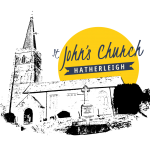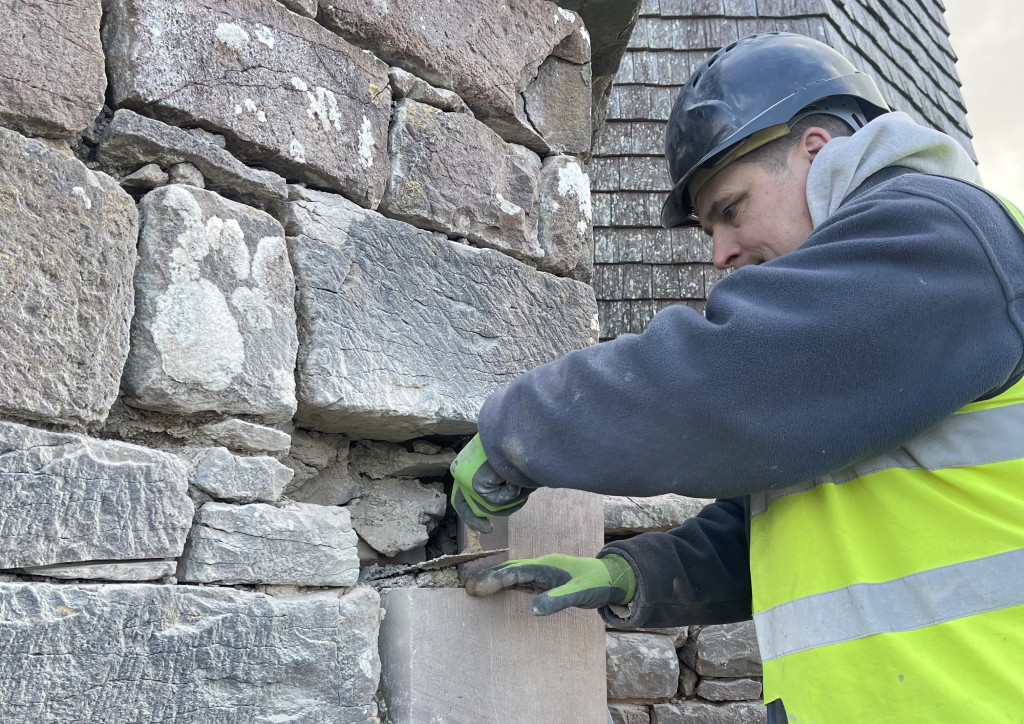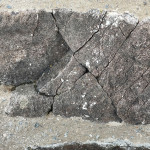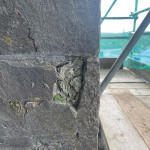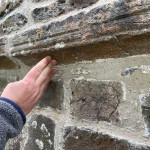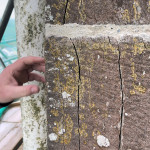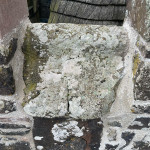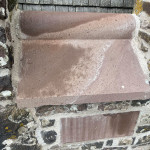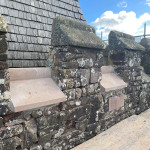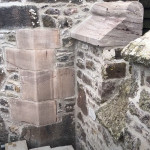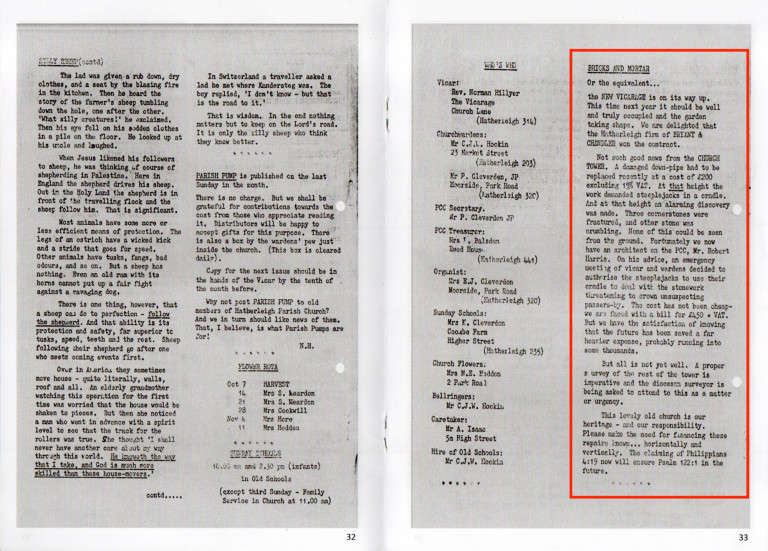Architect and Historic Building Consultant, Jeremy Chadburn, has been at the forefront of the ambitious tower conservation project, overseeing the meticulous work to restore the stonework of the tower, being carried out by Westcountry Stonemasons Ltd.
Crafted from local Hannaborough stone thought to be sourced from a quarry on Hannoborough Moor just outside of Hatherleigh, the tower’s construction is a superb testament to the skill and craftsmanship of its builders, yet the porous volcanic nature of the Hannaborough stone has left our tower vulnerable to deterioration, including cracking and shattering of the stones over the years.
Centuries of exposure to the elements and the change in present day weather patterns have all taken their toll on the tower’s stonework, particularly evident in the deterioration to the coping stones on the turrets at the top of the tower. With agreement from the Dioses Advisory Committee (DAC), Jeremy Chadburn has directed the use of “Callow Hill” stone for stonework replacements (where necessary), due to its superior quality and durability.
Significant restoration efforts have focused on the replacement of coping stones which frame the tower’s turrets, many of which had deteriorated beyond economical repair, posing safety hazards with fragments falling to the ground. Callow Hill stone not only ensures longevity compared to previous repair materials, but also offers a great colour match to the original masonry.
The stonemasons’ conservation approach prioritises preserving and stabilising the original stonework where possible, or replacing sections where it is not. The team at work on the tower have been using a combination of ‘pinning’ and ‘stapling’ to stabilise fractured sections of stone that had been in danger of coming loose.
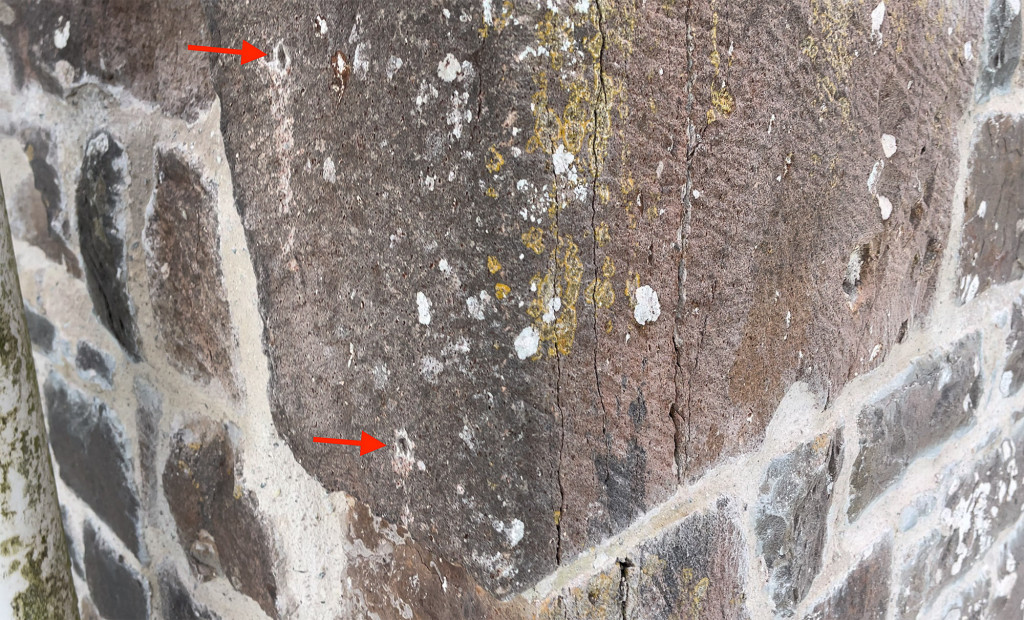
As part of this approach, stainless steel metal pins or staples are strategically pinned deep into fractured sections of masonry, using a special resin to bond them in place and stabilise the stone. The exposed ends of the pins are then buried under a layer of lime mortar to protect against further weathering and moisture ingress.
In certain areas of the tower, the decay of some pieces of the Hannaborough stone has meant they can’t be saved which has resulted in them being replaced with Callow Hill stone. Due to the porous volcanic quality of the original Hannaborough stone, it is inherently prone to cracking and shattering, this is further exacerbated by weathering and the gentle swaying movement of the tower caused regular ringing of the tower’s bells, which, sadly, has led to further deterioration over the years.
The following video shows one of the rain water deflectors on the tower, where the stone had disintegrated beyond economical repair, and has been replaced with a section of “Forest of Dean” stone, which is stronger and harder wearing again than the Callow Hill stone. The rain water deflectors on the tower take a lot of wear from weathering so an extremely durable stone was required.
In this second video, we contrast today’s best practice conservation approach of replacing the damaged section of stone with hard wearing stone, with a previous attempt to cast a concrete rainwater deflector ‘in-situ’ with wooden shuttering.
While visiting the stonemasons at work on the tower, it has been possible to view the tower up close and observe the different approaches towards its conservation over the years.
Historical repair attempts, including steeplejack work in the 1970s and the use of ironwork strapping, offer insights into different conservation approaches over the years, highlighting the challenges faced in preserving the tower’s integrity over time.
This 1979 extract from the Parish Pump (local parish magazine) talks about urgent repairs to the corner stones undertaken by steeplejacks.
Though these have been largely successful and stood the test of time, the use of iron strapping in isolation poses further risk, as the iron oxidises and deteriorates over time when exposed to weathering. This highlights why the more modern, internal pinning or stapling approach offers a better long term solution, as the new metal ties will be protected from the elements by resin and lime.
Past repairs to the tower, such as the replacement of lime mortar joints with cement mortar during the 18th and 19th centuries, have further contributed to the deterioration of the tower, leading to moisture penetration and internal dampness, accelerating timber decay in areas like the belfry and clock chamber.
Where cement mortar was employed, the non-permeable, brittle material eventually cracks during exposure to expansion and contraction throughout the seasons, creating hairline cracks which water finds its way in through. Once the water is in, freezing temperatures throughout our cold winters force the material to separate and become unstable and lead to further damaging water ingress. It is for this reason that as part of the current conservation work to the tower, all of the cement mortar joints have been raked out and have been replaced with traditional lime mortar pointing, which is water permeable and helps the building to ‘breath’ and regulate itself.
The conservation work to the stonework of the tower is on track to be completed by the end of May / early June 2024, and the stonemasons have recommended when returned, the bells should not be rung for 6 months from the completion of the masonry conservation work to allow the tower to properly settle and the lime mortar joints to properly cure.
Our Thanks
We would like to take the opportunity to extend our warmest thanks to those who have generously donated funds to enable us to continue with the ongoing restoration of the church.

These include Heritage Lottery Fund, Garfield Western Foundation, Devon Historic Churches, ‘All Churches’, Archdeacon’s Fund, Wolferstons, Hatherleigh Moor Management Committee, legacy giving, church fundraising, and donations from individuals.
Without these funds, none of what we are doing would be possible. Our thanks also go out to Marian Southwick who has worked tirelessly to coordinate and submit the many grant funding applications needed to make the restoration work at St John’s Church possible.

